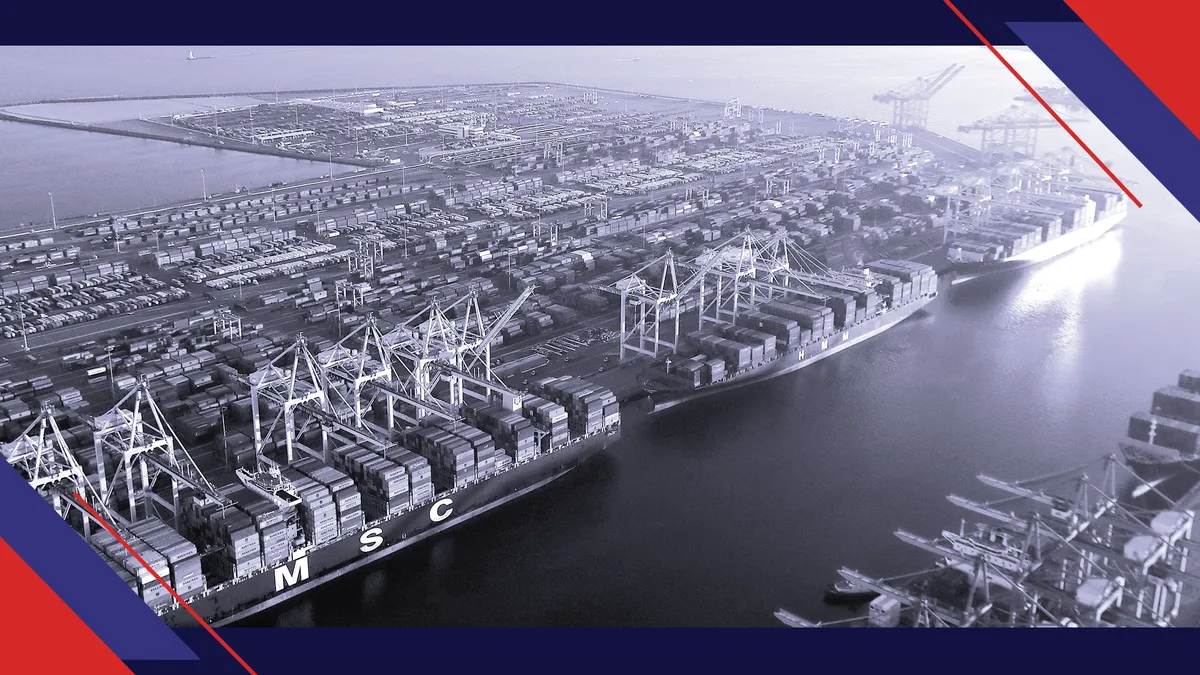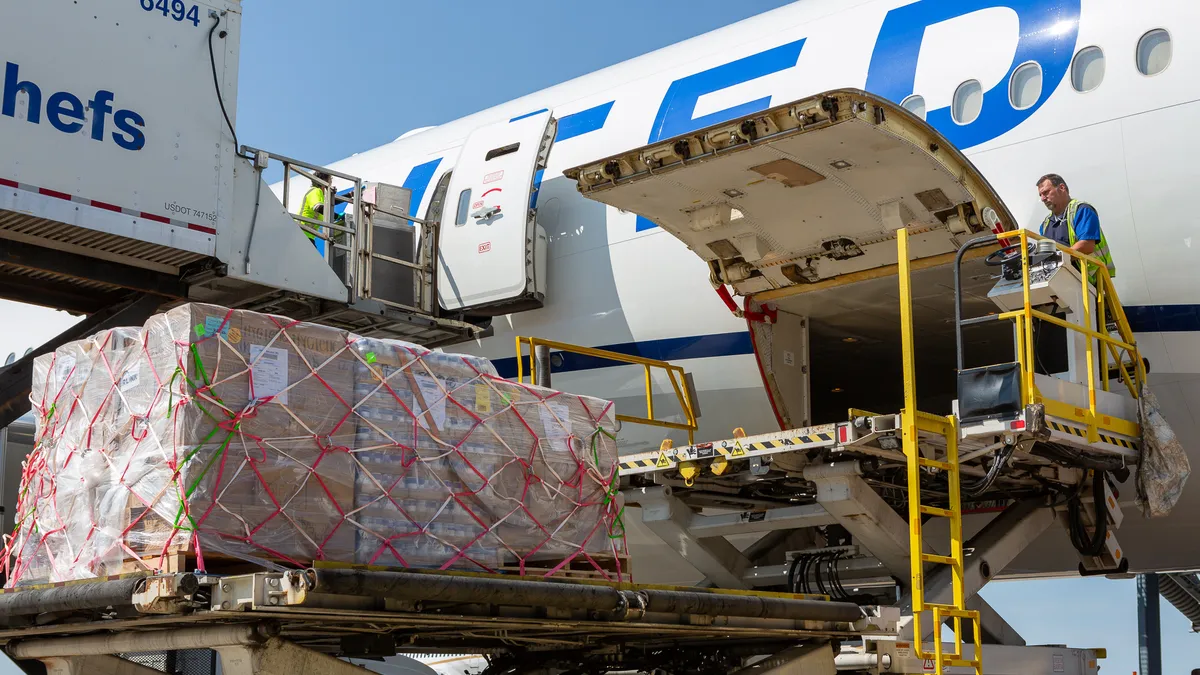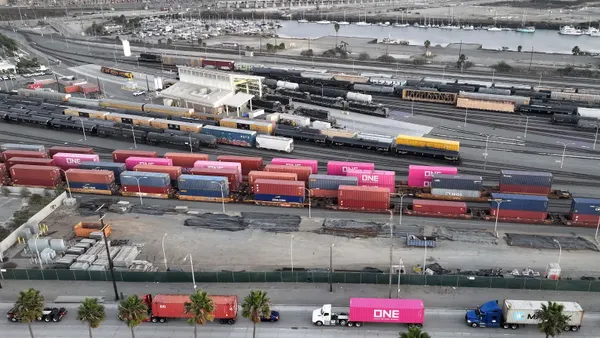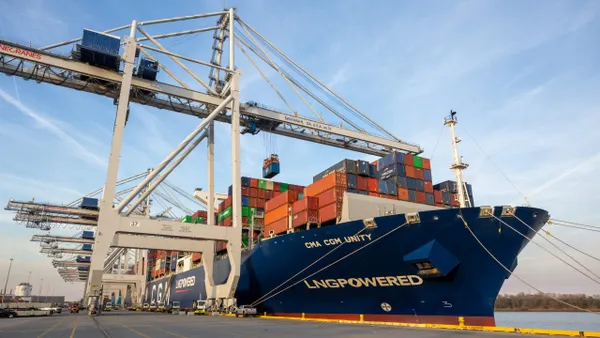This article is part of a series on the impacts climate change and severe weather have on supply chains. View the entire series here.
When Superstorm Sandy swept its way onto the shores of New York in 2012, it brought all the wind, water and fury that is typically associated with a hurricane. The region's supply chain infrastructure was not spared.
Red Hook Container Terminal at The Port of New York and New Jersey did not receive any cargo until eight days after Sandy made landfall. Tenants of the terminal reported they had up to five feet of water in their warehouse, according to a paper published last year by two University of Rhode Island researchers, John Ryan-Henry and Austin Becker.
"Hurricane Sandy was obviously a wake-up call for the region," Joshua DeFlorio, the chief of resilience and sustainability for The Port of New York and New Jersey, said in an interview. "It was for the Port Authority. It certainly was for the ports and its tenants as well."
That wake-up call led to a 2016 study of the port's preparedness for future events of coastal flooding, which is expected to become more common as the planet warms. (The Port Authority declined to share the report; a request for the document through the New York freedom of information law is still pending.) And the impact doesn't end at the port. The maritime supply chain is highly interconnected with rail networks, roadways, nearby warehousing space and electrical infrastructure all linked to ensure smooth operations.
This interconnection was seen rather clearly during Katrina when a 28-foot storm surge hit a refrigerated warehouse.
"That refrigerated warehouse was filled with chicken and pork bellies," Becker, a professor in The University of Rhode Island's Department of Marine Affairs, said. "And those frozen meat products, which were all in plastic bags, those got washed inland with that 28-foot storm surge and ... were distributed across the city. And so then, they rotted."
Local news reports say the rotting meat lingered around the neighborhood months later.
As ports consider the potential impact of climate change, they need to understand how all these assets fare in the face of rising tides, experts said. But some ports are preparing more than others.
"The fact that Hurricane Sandy was still fresh in the memory of many of the tenant representatives meant that most could recall which assets and infrastructure were impacted and explain how they had adjusted or adapted their operations to meet a future event similar to Sandy," Pianc, the World Association for Waterborne Transport Infrastructure, wrote in a report released last year entitled "Climate Change Adaptation Planning for Ports and Inland Waterways."
East Coast: Port of New York and New Jersey invests after Sandy
Ryan-Henry and Becker outlined the full damage from Sandy, showing that the storm damaged the port's berths, fuel pumps, transformers, underground infrastructure, computer systems, trucks, cranes and other infrastructure. Among the costs from the storm was the fact that cargo was delayed and rerouted to other ports.
Sarah Colasurdo, a senior climate resilience specialist at The Port of New York and New Jersey, said the storm led to multiple operational changes and structural upgrades. But as a tenant port, the facility relied on working with partners to ensure changes were made.
"The port department, I know they instituted entire incident command structure that was kind of really beefed up after Sandy," Colasurdo said. "And they also upgraded their hurricane preparedness plan."
Mid-level sea-level rise scenario in New York
Sea-level rise forecasts from the National Oceanic and Atmospheric Administration provide a number of scenarios based on various predictions of future carbon emissions. This chart uses predictions from the Intermediate Low Scenario and Intermediate Scenarios outlined here to roughly show a "likely" scenario.
Right after the storm, there was a rush to put in place temporary measures like flood barriers and retrofits to buildings that would help the port to better withstand the next hurricane season.
"But that's not really a wonderfully sustainable solution, because you don't want to spend the valuable few days before an impending storm event to be sending all of your labor out to put up deployable flood barriers," Colasurdo said.
It is better to be "passively protected," she said. This means taking steps like raising critical infrastructure to ensure it can withstand the next storm.
"The climate impacts that we're thinking about ... definitely don't respect any jurisdictional borders."

Sarah Colasurdo
A climate resilience specialist at The Port of New York and New Jersey
Some tenants at the port invested in new ship-to-shore gantry cranes because their motors flooded — the new ones had elevated motors. And some tenants built up the land in their facilities to be physically higher, allowing them to move equipment or containers there before a storm hits land.
But even with these steps taken, it won't be enough for all storms.
"You can't armor a port from the largest storm surge events," Colasurdo said. This is why investing in drainage infrastructure is also an important step for ports to take, allowing them to recover more quickly when floodwaters do encroach on their facilities.
West Coast: Port of Los Angeles assesses vulnerability, flooding risk
One of the ports that reviewed its exposure to sea-level rise is The Port of Los Angeles, which completed a report in 2018 that provided an overview of the facility's exposure to sea-level rise. In the last year and a half, the port has been focused on implementing the findings, according to Adrienne Newbold, the senior civil engineer at The Port of Los Angeles.
Los Angeles' review found its infrastructure, especially its newer infrastructure, is "extremely resilient," Newbold said. But the report still outlines a number of potential vulnerabilities that could impact port operations as soon as 2030, according to a copy of the document provided by the port.
The container terminals specifically have "very low vulnerability" to sea-level rise, according to the port's report. But liquid build facilities could face temporary flooding by 2030 with a model that uses 12 inches of sea-level rise and a storm tide. Pump stations and utilities (including transformers and pumping plants) could face flooding by 2050 and 2100, respectively.
Mid-level sea-level rise scenario at The Port of Los Angeles
Sea-level rise forecasts from the National Oceanic and Atmospheric Administration provide a number of scenarios based on various predictions of future carbon emissions. This chart uses predictions from the Intermediate Low Scenario and Intermediate Scenarios outlined here to roughly show a "likely" scenario.
Two of the major infrastructure projects that the port has taken on since the report that incorporate sea-level rise are the Wilmington Waterfront Promenade and the San Pedro Waterfront, two developments focused on recreational activity rather than cargo movement.
"We looked at sea level rise, and we actually raised our promenade to accommodate sea-level rise," Newbold said of the Wilmington effort.
The port already deals with occasional flooding and has faced 100-year floods without any major challenges, but that flooding could pose a threat to some transportation networks over time. Trucks for the most part can roll through small floods, but rail operations are shut down by three inches of water on the track, she said.
Some rail infrastructure could be impacted by rising storm tides as soon as 2030, according to the report. But it is the more permanent sea level rise that poses the greatest threat.
"Rail infrastructure will be inoperable under permanent inundation," the report warns. And raising rail infrastructure is not exactly easy.
"You'd have to raise the entire network," Newbold said. But rail connections on the port's terminals are at a height that is considered to be resilient, she said.
And raising that rail infrastructure will, at the end of the day, largely be the responsibility of the railroads, she said.
Railroads have acknowledged this threat to their infrastructure. Union Pacific said in a 2019 report that it was working to increase its infrastructure's resilience to climate change. And in a 2019 filing with CDP, CSX said sea-level rise could "result in decisions to possibly relocate infrastructure and assets along coastal cities and ports to more inland locations."
Which underscores a point that experts emphasized to Supply Chain Dive: Ports are interconnected systems, and working with partners needs to be a priority.
Ports, partners and a shared view of the future
The interconnectedness of supply chain infrastructure was one focus of Pianc's report released last year. It used the Port of Rotterdam as an example.
"From what I know, they are one of the [ports] that have done the most work on these kinds of interdependencies," Jan Brooke, chair of Pianc's permanent task group on climate change, said in an interview.
A port can turn itself into a fortress against sea-level rise, but there are a lot of third parties involved with ensuring that a port remains operational. Issues with any of these partners can spell trouble for the port, Brooke said.
"I suspect it's something that most haven't really got their heads around," she said.

Ports will need to take an inventory of their connected assets and determine the criticality of the infrastructure, Pianc suggests.
Colasurdo said that in New York, this has meant fostering relationships with utilities, port tenants and other government agencies. Pianc's report noted that a lack of electricity after Sandy was one of the biggest problems for many port tenants.
"The [Port Authority] is working with the local utility provider to better protect the electrical equipment on the Port in preparation for future flooding events," the report states.
It's helpful for partners to work with the same sea-level rise forecasts, so they share the same data and view for the future, Colasurdo said.
"The climate impacts that we're thinking about ... definitely don't respect any jurisdictional borders. They don't care where our port ends and the highways begin," she said.
But as ports are beginning to do the work to build resiliency against climate change, experts said they're doing the work largely on their own, even though some professional organizations, like Pianc, have begun to assist in knowledge sharing in the space.
A lack of standards and mandates
While Los Angeles and New York have begun resiliency planning, they could be in a minority of U.S. ports, according to a recent survey done by Becker that looked at ports that have gone through a resilience assessment planning process in the last decade. (Becker's research is not yet published, but he spoke about his draft findings in an interview.)
"It turns out, there aren't actually that many that have," he said. "There are about 300 or so ports in the U.S. and ... we were able to find about 10 that have gone through a resilience planning process."
Brooke said it usually takes a risk event before ports begin to engage in resilience planning.
"Most ports start to take climate change seriously, either when they just have a hit, or when they just had a near miss from extreme weather," she said.
The takeaway is that it's hard to plan for sea-level rise if there hasn't been an assessment of the potential impact on the port facility, Becker said, noting that it's an important first step.
"There are about 300 or so ports in the US and ... we were able to find about 10 that have gone through a resilience planning process."

Austin Becker
Professor in The University of Rhode Island's Department of Marine Affairs
At one point, there was federal guidance on this issue. Under the Obama administration, an executive order was passed that required any infrastructure project that used federal funds to consider the impact of sea-level rise in its design. The requirement was revoked under the Trump administration, according to Benjamin Sweeney, who wrote his Master's thesis at the University of Rhode Island on port infrastructure engineering standards for sea-level rise.
"I think that executive order, even though it was revoked during the Trump administration, at least ... provides some really concrete guidance that engineers can use and point back to when justifying their decisions of why they designed to this level or that level," Sweeney said.
Incentive to change
As part of his thesis research, Sweeney surveyed 85 port and marine infrastructure engineers. The survey again showed a lack of sea-level rise documentation with 64% saying they do not have "a policy or planning document that communicates how future [sea level change] should be incorporated into port infrastructure projects."
The cost of large-scale port infrastructure projects is not cheap. Even just retrofitting the cranes at Red Hook Container Terminal following Sandy racked up a bill of "about $160,000 per crane," according to Ryan-Henry and Becker's paper. Plenty of other projects have price tags into the hundreds of millions of dollars.
"It's really important to make sure that the investment that's being put into these projects will be sustained," Sweeney said.
There could be more formal guidance from the federal government on the way. Becker said he's working with the Army Corps of Engineers and the Department of Homeland Security's Cybersecurity and Infrastructure Security Agency on a resilience-planning guide for port stakeholders.
And the Biden administration mentions ports multiple times in its infrastructure proposal.
"President Biden is calling on Congress to invest an additional $17 billion in inland waterways, coastal ports, land ports of entry, and ferries, which are all essential to our nation’s freight," the White House said in a fact sheet on its proposal.
It mentions a "Healthy Ports" program to deal with air pollution from these facilities, but it doesn't address sea-level rise specifically. Details of the program have yet to be laid out, but the White House says it is meant to "mitigate the cumulative impacts of air pollution on neighborhoods near ports, often communities of color." A White House spokesperson did not respond to multiple requests to comment on the considerations of sea-level rise in the infrastructure bill.
Even if there's more guidance from the public sector, without a mandate, many ports could choose not to undergo the resilience planning, Becker said. He noted that California has a mandate in place that requires ports to undergo resilience planning for its facilities. But nationwide, there is no such requirement.
"There really aren't great incentive structures in place for them to decide to undertake this kind of a study," he said. "Often, you'll have some staff members who recognize the importance of it, and so they'll push for it. But that's not always the case."
Incentive structures could come in the form of federal grant requirements that mandate ports to do these types of studies, Becker said. In the meantime, shippers will have to navigate a port ecosystem where some facilities are preparing for climate change and others are not.
Correction: A previous version of this story said Red Hook Container Terminal is the largest at the Port of New York and New Jersey. It is not.















